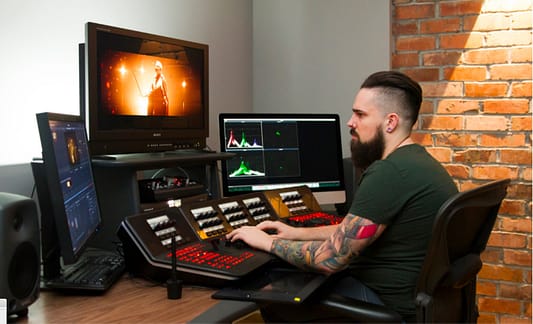Day 25: 25 Insights in 25 Days New Year Marathon
Getting To Know Remote Grading & How It Can Help Your Color Correction Business
About four or five years ago while checking out my Twitter feed, I noticed a trend from some A-List colorists that I follow:
‘Great session with clients from Helsinki, can’t wait to visit Finland! – L.A. Based Colorist
‘Awesome grade today on a new Honda spot remote to Tokyo’ – NYC Based Colorist
‘Starting to like remote grading, but have to remember to clean my teeth after lunch! – London Based Colorist
Hmmm – what are these folks up to I thought.
Well, it turns out the big facilities with A-list talent figured out not only how to get more top dollar work for their top colorists, but also figured out how to expand their sphere of influence with a relatively minimal investment.
From the moment I started hearing about remote grading, I started to get interested in it.
Over the past few years I’ve slowly but steadily built my remote grading capabilities from a technical standpoint, but have also started to figure out perhaps the more important part – how to market and sell remote services to clients.
It’s a detailed and interesting subject, so I thought why not start a new series on the subject!
In part 1 (this Insight) I want to explore what remote grading is, how it can impact your bottom line, and share some essentials on how to market it.
In part 2, we’ll take a look at the technical aspects of a remote grading session – including common solutions & getting everything set up.
Finally, in part 3, we’ll take a look at how to run and manage a remote session (yes! It can be a little weird).
What’s Remote Grading?
Remote grading means slightly different things depending on who you’re talking to, and what they’re familiar with.
When I first started looking into remote grading a few years ago, I was initially confused as it seemed like people were talking about a couple different methods.
After researching this a bit more, remote grading really comes down to two main ways of doing things:
- Grading System To Grading System – This type of remote grading is one grading system taking control of another system. For example, Resolve remote grading works like this – one Resolve system taking control over another Resolve system. Many popular grading applications have similar functionality to how Resolve handles remote grading. In general, the same version of software needs to be loaded on both ends & the same media also needs to be located on both sides. Conversations with the controlling colorist are done over a phone call, Skype, FaceTime or similar.
- Streaming – Most of the time, especially these days, when someone mentions remote grading, they’re usually referring to streaming content in real-time with minimal delay from a grading suite to a remote location. Instead of needing grading systems on either end, the setup is usually the grading system output to a streaming encoder > streaming decoder > color calibrated display in the remote location > client watching your amazing grading work! In this setup, media only needs to be located on one side. Conversations are also typically done over a phone call, Skype or FaceTime.

In either case, hardware and technology play a big role (more on that in part 2). In the system to system approach, it’s going to be a requirement that you have two of the same systems – one in each location.
With the streaming approach real-time encoding/decoding hardware/software is necessary, as is a stable & fast internet connection.
Calibrated monitoring in either approach is, of course, necessary.
Why I Went Down The Path Of Remote Grading
Every time I read a tweet about a remote session from an A-list colorist I started daydreaming of working with high-brow clients all over the world – then that record scratch sound played in my head and I came back to reality!
The fact is, I’m not Dave Hussey, Ivan Lucas, Steve Scott or any of the other dozen or so top colorists in the world. In addition, no one mentions my facility in the same breath as Technicolor, or EFILM.
Right off the bat, even though I romanticized the idea of remote grading, I was down on the idea of investing both money and time in building a remote grading solution.
That is until I started thinking about why large facilities were offering remote grading services.
The first thing that came to mind was these large facilities were offering productions of all types access to some of the best colorists in the world. But then I realized it was more than that – remote grading allows a company to expand their geographic reach – and that is something I longed for as well!
In almost 20 years of being a colorist in my market, I’ve worked with nearly all of the potential clients in my proverbial pond. That’s allowed me to earn a very good living and be very satisfied with the projects I’ve worked on and relationships that I’ve built.

However, right around the time I discovered remote grading, I started feeling that the only way to grow my color correction business was to branch out into other markets.
But how could I do that? I didn’t have the capital to build another facility in another location, not to mention the manpower to do so.
That’s when it dawned on me that remote grading was the solution and offered several advantages to traditional expansion:
- Low Cost – For less than $12,000 I could build a remote solution hardwired into my facility, provide a software decoding option for clients & provide a mobile solution with color critical monitoring that I could send out to a client as needed. Twelve grand is still a lot of money, but significantly cheaper than the six-figures necessary to expand a brick and mortar solution into another market.
- More Flexible – Let’s say I choose to expand my business into New York and assuming that I could afford to open the doors to a facility, pay people to work there, market the facility properly (all not very likely), I would still be entering a single market. Remote grading allows you to be anywhere in the world!
- Considerably Less Risk – I’ve seen many companies fail because of ill-planned expansion – opening a location in a new market not only costs a lot of money, but there is considerable risk in simply acquiring work in that new market. While the marketing challenges still exist with remote grading, even if you are never able to secure a single remote client (you can!) the loss from the investment is considerably less, and more recoverable compared to a traditional expansion.
At this point, you probably want to know more about the gear and technical aspects of a remote grading solution – I promise we’ll get to that in part 2. But more to the point – talking about the gear first is putting the cart before the horse.
To make sure that your investment in the long term is a profitable solution you need to put the leg work & research into understanding the marketing of such a solution and figuring out who & where potential remote clients are.
Member Content
Sorry... the rest of this content is for members only. You'll need to login or Join Now to continue (we hope you do!).
Need more information about our memberships? Click to learn more.
Membership optionsMember Login


